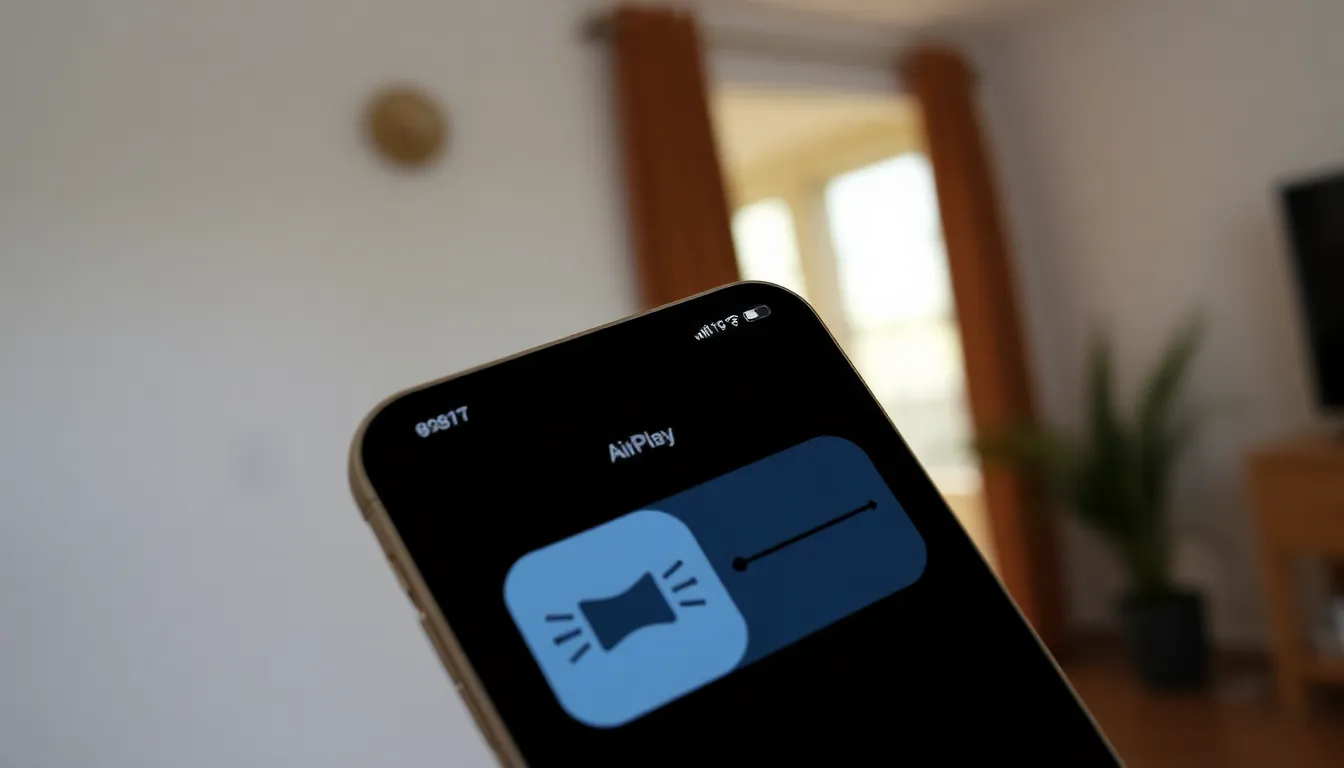In a world where streaming and mirroring have become second nature, AirPlay can sometimes feel like an overzealous party guest that just won’t leave. Whether it’s your favorite show hijacking the living room TV or that unexpected karaoke session blasting through the speakers, knowing how to disconnect AirPlay on an iPhone is essential for reclaiming control over your devices.
Table of Contents
ToggleUnderstanding AirPlay on iPhone
AirPlay allows iPhone users to stream audio, video, and photos wirelessly to compatible devices. It enhances the media experience by providing seamless connectivity.
What Is AirPlay?
AirPlay is a proprietary protocol developed by Apple. This feature enables users to share content from their iPhone to televisions, speakers, or other devices. With AirPlay, streaming supports various formats, ensuring quality playback. Users can easily connect to devices, creating an efficient way to enjoy digital content.
How AirPlay Works
AirPlay leverages Wi-Fi to create a connection between devices. When an iPhone finds a compatible device on the network, users can tap the AirPlay icon to start streaming. It utilizes a combination of protocols to ensure smooth playback and controls. Users can stream content directly from apps, extending their experience to larger screens or high-quality speakers.
Steps to Disconnect AirPlay on iPhone

Disconnecting AirPlay can quickly restore control over your devices when unwanted streaming occurs. Users can choose between two main methods: using the Control Center or accessing the Settings app.
Disconnecting via Control Center
Begin by swiping down from the top-right corner of the screen. Look for the AirPlay icon, which resembles a triangle and a rectangle. Tapping this icon reveals connected devices. Select the currently connected device to disconnect. Confirmation of disconnection appears with a status change in the icon, ensuring no content streams from your iPhone.
Disconnecting via Settings
Open the Settings app to find the option for AirPlay. Scroll down to the “AirPlay & Handoff” section. Toggle off the AirPlay option to disable it entirely. Verification will display on the screen once AirPlay is disconnected. This method provides a broader approach, disabling AirPlay functionality until re-enabling it when needed.
Common Issues When Disconnecting AirPlay
Disconnecting AirPlay can present certain challenges. Users may encounter various problems that disrupt the process and hinder the intended experience.
Connection Problems
Connection problems may arise when trying to disconnect from AirPlay. Interference from Wi-Fi signals can prevent successful disconnection. A weak signal often leads to difficulties, making it hard for devices to communicate. Users should check network strength and ensure both the iPhone and target device are on the same Wi-Fi network. Restarting both devices can also help resolve temporary connectivity issues. Occasionally, software updates may affect performance, so keeping devices updated ensures compatibility. Checking Network Settings under the iPhone’s control can also introduce clarity regarding connection status.
Device Not Responding
Devices sometimes fail to respond when disconnecting from AirPlay. This lack of response may occur due to temporary software glitches. Users can solve this by force quitting the AirPlay app they’re using. Alternatively, they might try to restart their iPhone, as this action resets the connection process. If a device remains unresponsive, checking the device’s compatibility with AirPlay is wise. In some instances, device settings may need adjustment, requiring users to navigate to Bluetooth settings to ensure connection stability. Users can also ensure that both the iPhone and target device are up to date, which minimizes potential interaction issues.
Alternatives to AirPlay
Multiple options exist for streaming media beyond AirPlay. Users can explore different wireless and wired methods to connect their devices seamlessly.
Other Wireless Streaming Options
Chromecast offers a strong alternative for casting content from smartphones or tablets. Supporting various apps, it allows users to stream videos and music on compatible TVs. Miracast, found in many Android devices, provides a way to mirror screens wirelessly. DLNA serves as another option for sharing content across devices on the same network. Each of these alternatives accesses valuable media without relying solely on AirPlay.
Wired Connection Methods
HDMI cables deliver reliable, high-quality audio and video directly from devices to TVs. Using a Lightning to HDMI adapter enables iPhone users to connect easily to TV screens. VGA cables represent another option for visual output, though they lack audio support without additional adapters. Connecting devices through USB-C creates opportunities for streaming via compatible displays. These wired methods offer stability and eliminate the connectivity issues sometimes associated with wireless streaming.
Disconnecting AirPlay on an iPhone is essential for anyone wanting to maintain control over their media experience. By following the straightforward methods outlined in the article users can easily regain access to their devices without hassle. Whether using the Control Center or the Settings app both options provide a quick solution to an unexpected streaming takeover.
Addressing potential connection issues ensures a smoother disconnection process. Understanding alternatives to AirPlay also broadens the options for streaming content, giving users flexibility in how they enjoy their media. With these tips in hand anyone can confidently manage their AirPlay settings and enhance their overall viewing experience.




